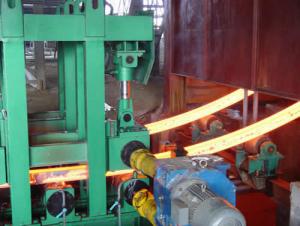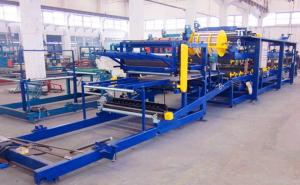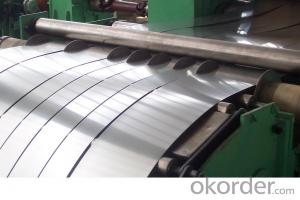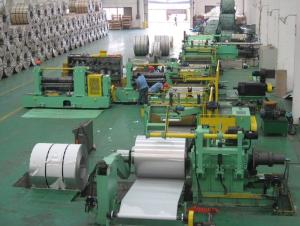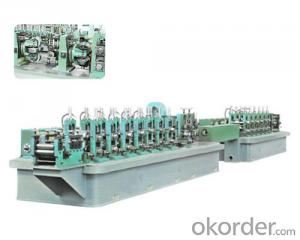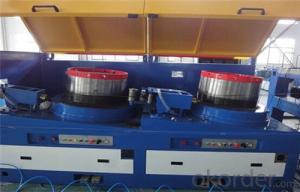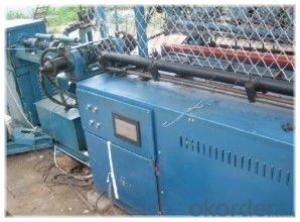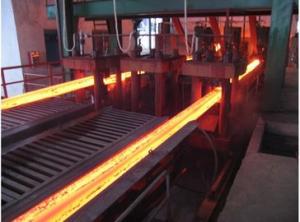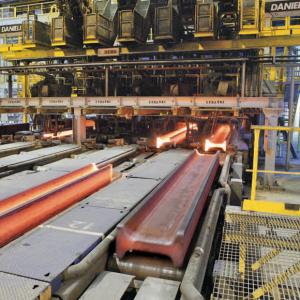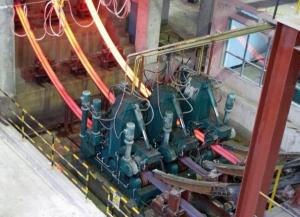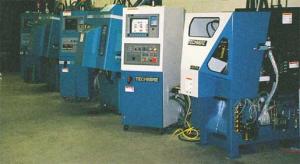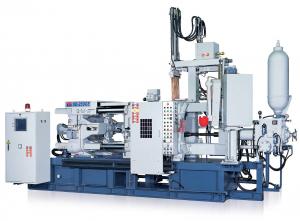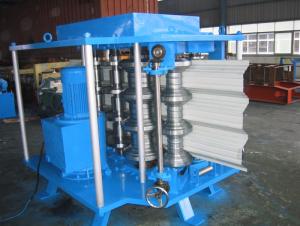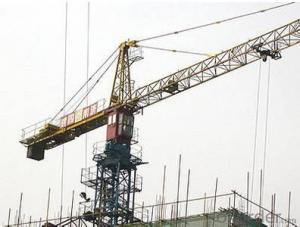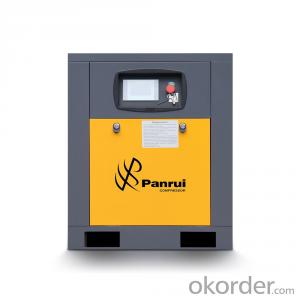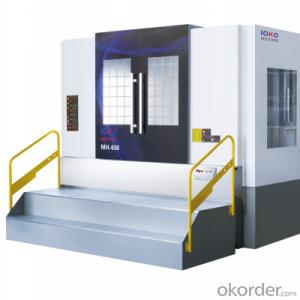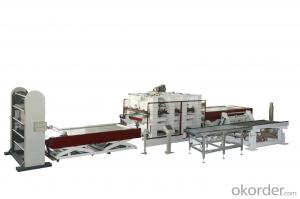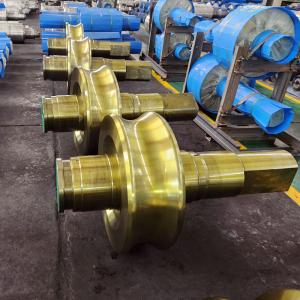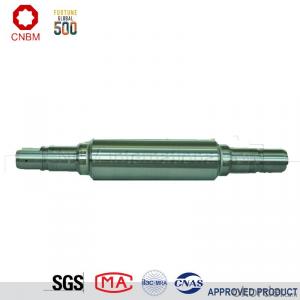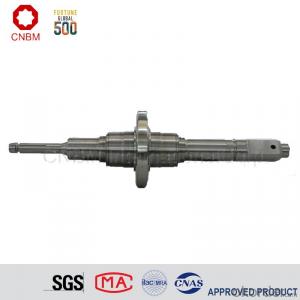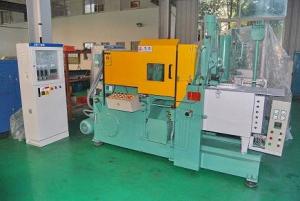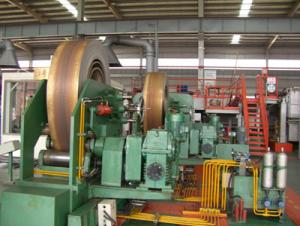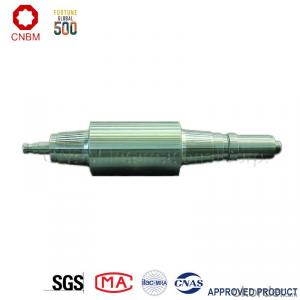Steel Continuous Casting Machine
- Loading Port:
- China Main Port
- Payment Terms:
- TT or LC
- Min Order Qty:
- 1 Set set
- Supply Capability:
- 30 Sets Per Year set/month
OKorder Service Pledge
Quality Product, Order Online Tracking, Timely Delivery
OKorder Financial Service
Credit Rating, Credit Services, Credit Purchasing
You Might Also Like
Technology process:
1.Heat the EVA film
2.Cover the heated EVA film on the mould(can be made from wood or aluminum)
3.Spray a coating in a certain baume degree
4.Put on the empty blask
5.Sand-up the flask and vibrate to compaction
Packaging & Delivery
Packaging Details:containers
Delivery Detail:Complete one set of equipment needs for three months
- Q:How is the casting tested for pressure or leak tightness in metal casting machinery?
- The casting testing for pressure or leak tightness in metal casting machinery is typically done through a process called pressure testing. This involves subjecting the castings to internal or external pressure to determine their ability to hold and withstand pressure without any leakage. There are various methods used for pressure testing, depending on the specific requirements of the casting and the machinery. One commonly used method is hydrostatic pressure testing, where the casting is filled with a liquid, usually water, and pressure is applied to assess its tightness. This test involves pressurizing the casting above its expected operating pressure and checking for any leaks or pressure drops. Another method is pneumatic pressure testing, where compressed air or gas is used to pressurize the casting. Similar to hydrostatic testing, the casting is filled with air or gas and subjected to higher pressures to check for any leaks or pressure loss. In addition to these methods, there are also specialized testing techniques like vacuum testing, where the casting is placed in a vacuum chamber and the air pressure is reduced to check for any air leaks. This method is particularly useful for detecting leaks in sealed or enclosed castings. Furthermore, advanced technologies such as computerized pressure testing systems and automated equipment are often employed to ensure accuracy and efficiency in the testing process. These systems can monitor pressure levels, record data, and provide visual or audible alerts in case of leaks or pressure abnormalities. Overall, the casting testing for pressure or leak tightness plays a crucial role in ensuring the quality and reliability of metal casting machinery. It helps identify any potential weaknesses or defects in the casting, allowing for necessary repairs or adjustments to be made before the machinery is put into operation.
- Q:What are the different types of noise control measures used in metal casting machinery?
- There are several different types of noise control measures that can be used in metal casting machinery to reduce or eliminate excessive noise levels. These measures can be categorized into engineering controls, administrative controls, and personal protective equipment (PPE). 1. Engineering Controls: These measures are focused on modifying the design or structure of the machinery to minimize or control noise emissions. Some common engineering controls used in metal casting machinery include: - Enclosures or barriers: Constructing soundproof enclosures or barriers around the machinery can help to contain the noise and prevent it from spreading into the surrounding environment. - Vibration isolation: Installing vibration isolation mounts or pads can reduce the transmission of noise through the machine structure by isolating and damping vibrations. - Absorption materials: Using sound-absorbing materials, such as foam or acoustic panels, on the surfaces of the machinery can help to absorb the noise generated during the casting process. - Damping treatments: Applying damping treatments, such as viscoelastic coatings or constrained layers, to the machinery's surfaces can help to reduce vibration and noise. 2. Administrative Controls: These measures involve implementing operational or administrative strategies to control noise exposure. Examples of administrative controls used in metal casting machinery include: - Limiting exposure time: Implementing work schedules that limit the time workers spend near the machinery can help to reduce their overall noise exposure. - Maintenance and repair: Regular maintenance and repair of the machinery can prevent malfunctions or worn-out components that may contribute to excessive noise levels. - Training and education: Providing workers with proper training and education on noise hazards and effective noise control measures can help to raise awareness and promote safe practices. 3. Personal Protective Equipment (PPE): PPE is the last line of defense when other noise control measures are not feasible or have not adequately reduced noise exposure. Some commonly used PPE in metal casting machinery include: - Earplugs: These are inserted into the ear canal to reduce the amount of noise reaching the ear. - Earmuffs: These cover the entire ear and provide a physical barrier against noise. - Noise-canceling headphones: These headphones use technology to actively cancel out or reduce ambient noise. It is important to note that a combination of these noise control measures is often the most effective approach to minimize noise exposure in metal casting machinery. Implementing a comprehensive noise control program that includes a range of engineering, administrative, and PPE measures can help to ensure a safe and healthy work environment for employees.
- Q:What are the common software programs used in metal casting machinery?
- In metal casting machinery, numerous software programs are employed to optimize and streamline the casting process. Among the most frequently utilized programs is CAD software, which engineers use to create detailed 3D models of casting designs. This software aids in visualizing the final product, making modifications, and generating precise engineering drawings. Another software of great importance in metal casting machinery is CAM software, which takes the 3D models created in CAD software and converts them into instructions that machines can read. It determines the tool paths, cutting speeds, and feeds necessary for the casting process, ensuring accuracy and efficiency. Simulation software is also extensively used in the metal casting industry. This software permits virtual testing and analysis of the casting process before it is actually implemented. It aids in identifying potential defects, optimizing casting parameters, and predicting the behavior of molten metal, ultimately enhancing the final casting quality. Moreover, there exist quality control software programs that monitor and analyze data collected during the casting process. These programs assist in real-time identification of any deviations or defects, ensuring that the casting meets the required specifications and standards. Additionally, various ERP software systems are employed in the metal casting industry. These programs facilitate the management of the entire casting process, from material procurement to scheduling, inventory management, and order tracking. They provide a centralized platform for efficient resource allocation, communication, and coordination between different departments involved in the casting operations. In summary, the software programs commonly used in metal casting machinery play a crucial role in increasing productivity, accuracy, and quality control in the casting process. They enable efficient design, precise manufacturing instructions, virtual testing, quality assurance, and streamlined management of overall casting operations.
- Q:How is the surface finish of the castings achieved using metal casting machinery?
- The attainment of the surface finish of castings is accomplished by utilizing metal casting machinery, employing a blend of diverse procedures and methods. A primary method employed is known as sand casting, wherein a mold is formed by compressing sand around a pattern with the desired shape. Subsequently, the sand mold is filled with molten metal, which solidifies, resulting in the formation of the casting. To attain the desired surface finish, the quality of the sand employed in the mold is of utmost importance. The sand ought to possess a fine grain size and be devoid of impurities to guarantee a seamless surface. Furthermore, the sand mixture may undergo treatment with additives or coatings to enhance the quality of the surface. The design of the mold is another crucial factor in achieving a satisfactory surface finish. The mold cavity should be appropriately designed to facilitate the smooth flow of the molten metal and minimize the occurrence of defects such as porosity or shrinkage. The utilization of gating systems, runners, and risers also plays a pivotal role in regulating the flow of the molten metal and promoting controlled solidification. Upon solidification of the casting, subsequent techniques may be employed to further enhance the surface finish. These techniques may encompass grinding, sanding, or polishing to eliminate any excess material, burrs, or rough edges. Surface treatment methods such as shot blasting, electroplating, or painting may also be employed to augment the appearance and safeguard the casting against corrosion. In summary, the attainment of the desired surface finish in castings through the use of metal casting machinery necessitates a combination of meticulous mold design, appropriate sand selection, and post-processing techniques to ensure the production of a smooth and aesthetically pleasing final product.
- Q:How does metal casting machinery handle the removal of gas defects from the castings?
- Metal casting machinery handles the removal of gas defects from castings through various methods, such as utilizing vacuum systems, degassing agents, or using specialized casting techniques. These methods help to reduce or eliminate gas bubbles or voids in the molten metal, ensuring the production of high-quality castings.
- Q:What are the different types of melting furnaces used in metal casting machinery?
- There are several types of melting furnaces used in metal casting machinery, each with its own unique features and advantages. Some of the commonly used melting furnaces include: 1. Cupola Furnace: This is one of the oldest types of melting furnaces, traditionally used for melting iron. It consists of a cylindrical structure lined with refractory bricks and is fueled by coke or charcoal. Cupola furnaces are known for their high melting capacity and ability to produce a large amount of molten metal. 2. Electric Arc Furnace (EAF): These furnaces use electric arcs generated by graphite electrodes to melt the metal. EAFs are versatile and can be used for melting various types of metals, including steel, aluminum, and copper. They offer precise temperature control, energy efficiency, and the ability to use recycled scrap metal as a raw material. 3. Induction Furnace: Induction furnaces use electromagnetic induction to generate heat and melt the metal. They are known for their high energy efficiency and ability to quickly melt various metals, including steel, cast iron, and non-ferrous alloys. Induction furnaces offer excellent temperature control, low metal loss, and are suitable for small to medium-scale production. 4. Crucible Furnace: This type of furnace consists of a crucible made of refractory material, such as clay or graphite, in which the metal is melted. Crucible furnaces are commonly used for small-scale or artisanal metal casting. They are easy to operate, cost-effective, and suitable for melting low-melting-point metals like bronze or aluminum. 5. Reverberatory Furnace: Reverberatory furnaces have a shallow hearth where the metal is heated by direct contact with the hot gases produced by fuel combustion above it. They are mainly used for melting non-ferrous metals like copper, lead, or zinc. Reverberatory furnaces offer good temperature control, efficient fuel consumption, and the ability to recover valuable byproducts like zinc oxide. 6. Coreless Induction Furnace: These furnaces use an induction coil to create a magnetic field that induces eddy currents in the metal charge, resulting in heating and melting. Coreless induction furnaces are typically used for melting large amounts of non-ferrous metals, such as aluminum or copper alloys. They offer high efficiency, excellent temperature control, and low metal loss. Each type of melting furnace has its own advantages and suitability for specific applications. The choice of furnace depends on factors like the type of metal being melted, the required melting capacity, energy efficiency, and cost-effectiveness.
- Q:How is the noise level reduced in metal casting machinery?
- The noise level in metal casting machinery is reduced through various methods such as using soundproof enclosures, installing vibration isolation systems, implementing damping materials, and employing noise-reducing technologies like mufflers or silencers.
- Q:What are the waste reduction methods for metal casting machinery?
- There are several waste reduction methods that can be implemented for metal casting machinery. These methods aim to minimize waste generation, increase efficiency, and promote sustainability in the casting process. One notable method is to implement a closed-loop cooling system. This involves recirculating the water used for cooling the machinery instead of continuously using fresh water. By doing so, the amount of water consumed is reduced, leading to a decrease in water waste. Another effective waste reduction method is to implement a scrap management system. This involves segregating and categorizing the different types of scrap generated during the casting process. By doing so, scrap materials can be effectively recycled or reused, reducing the amount of waste sent to landfills. Additionally, optimizing the casting process itself can also contribute to waste reduction. This can be achieved through the implementation of advanced technology and automation systems. By carefully monitoring and controlling the casting process parameters, such as temperature and timing, the amount of defective castings can be minimized, reducing waste. Furthermore, implementing proper material handling and storage techniques can also help reduce waste. This involves proper inventory management, ensuring that the right amount of materials is available and that they are stored in appropriate conditions to prevent damage or spoilage. Lastly, regular maintenance and equipment inspections are crucial in waste reduction. By keeping the machinery in optimal condition, the risk of breakdowns and malfunctions is reduced, leading to fewer material and energy wastages. In conclusion, waste reduction methods for metal casting machinery include implementing closed-loop cooling systems, scrap management systems, optimizing the casting process, proper material handling and storage techniques, and regular maintenance and equipment inspections. By implementing these methods, manufacturers can minimize waste generation, increase operational efficiency, and contribute to a more sustainable casting process.
- Q:How does metal casting machinery handle the removal of sand from castings?
- Metal casting machinery typically handles the removal of sand from castings through a process called shakeout. Shakeout involves vibrating or shaking the castings to dislodge and remove the sand from the surface. This is usually done in a separate vibrating chamber or by using specialized equipment such as shakeout tables or shakeout drums. Once the sand is loosened, it is collected and recycled for future use in the casting process.
- Q:Can metal casting machinery be used to make complex shapes?
- Yes, metal casting machinery can be used to make complex shapes. The process of metal casting involves pouring molten metal into a mold, allowing it to solidify, and then removing the mold to reveal the final shape. This technique allows for the creation of intricate and detailed designs, making it suitable for producing complex shapes in various industries such as automotive, aerospace, and art.
Our professions include metallurgical technology, equipment and automation. We can provide the best solutions to the production process, design & manufacture of equipment and electrical automation regarding various industries in domestic and foreign districts with exquisite technology and fine quality service. We can provide all-around services to customers from development & design to the provision, installation and running of products.Strong technical strength, advanced equipment manufacturing technology, fine quality professional talents, and perfect service systems all bring about reliability, relaxation, convenience and delight to the cooperation with customers from beginning to end.
1. Manufacturer Overview |
|
|---|---|
| Location | Jiangsu,China (Mainland) |
| Year Established | 2000 |
| Annual Output Value | |
| Main Markets | South America Eastern Europe Southeast Asia Africa Mid East South Asia Domestic Market |
| Company Certifications | |
2. Manufacturer Certificates |
|
|---|---|
| a) Certification Name | |
| Range | |
| Reference | |
| Validity Period | |
3. Manufacturer Capability |
|
|---|---|
| a)Trade Capacity | |
| Nearest Port | SHANGHAI |
| Export Percentage | 21% - 30% |
| No.of Employees in Trade Department | 3-5 People |
| Language Spoken: | English, Chinese |
| b)Factory Information | |
| Factory Size: | |
| No. of Production Lines | |
| Contract Manufacturing | |
| Product Price Range | |
Send your message to us
Steel Continuous Casting Machine
- Loading Port:
- China Main Port
- Payment Terms:
- TT or LC
- Min Order Qty:
- 1 Set set
- Supply Capability:
- 30 Sets Per Year set/month
OKorder Service Pledge
Quality Product, Order Online Tracking, Timely Delivery
OKorder Financial Service
Credit Rating, Credit Services, Credit Purchasing
Similar products
New products
Hot products
Related keywords
